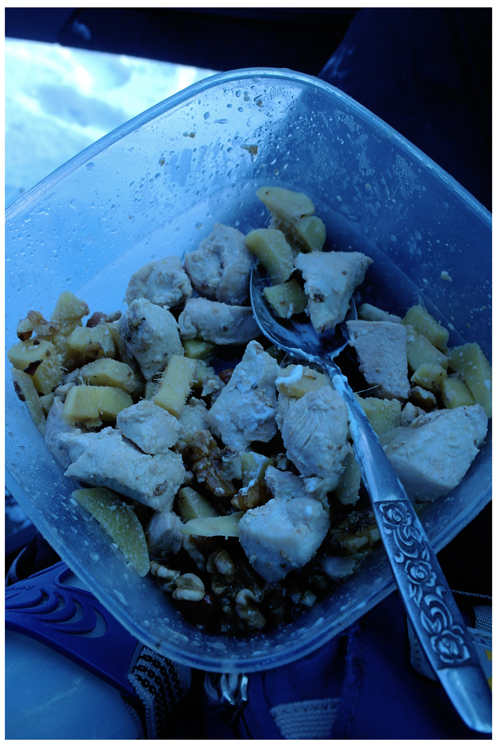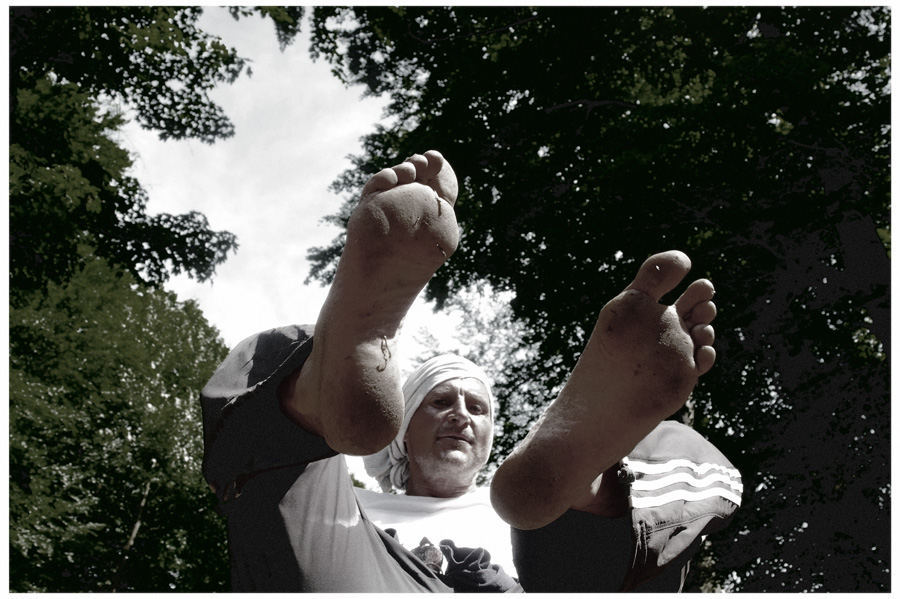SAR_sarsential™_toolbox_1/14
- Details
- Hits: 6707

Above: PGIA SAR 30K BLT. SAR [ Sarsential 1 ] : empty canvas [ route, terrain ].
"Barefeet keep me running. Shoes keep shoes running." Anonymous
"Peace is easily maintained;
Trouble is easily overcome before it starts.
The brittle is easily shattered;
The small is easily scattered.
Deal with it before it happens.
Set things in order before there is confusion."
Lao Tze
Winter_fun
- Details
- Hits: 6624

Velsen, 22 Januari 2013.
Deep blue reflections in the shadow, making the skin appear extra purple. Notice the difference in skin tone between shadow and highlight area. Red/pinkish in the sun. Purple in the shadow. Purple spot right foot/left side is real but exaggerated by blue skylight (scar running shoe injurie 2002).

Above: Chicken, ginger and nuts taken after relaxing, fun dune/beach barefoot training. There was a gentle wind from the east, dry -- the sun was shining. Temperature was aprrox. -3 D/Celcius. Good calm sea (for surf-running), comfortable low tide. More about food here.

Above: Route 22 januari 2013. Route covered with nice, clean, crisp snow and icelayer.

Above: One hour later
Jump
- Details
- Hits: 6511
Kennemer Dunes national park, today. Act first [ think later ]
Min/max temperature: -3°C/6°C; humidity: 66%; precipitation: 0 mm, sea level pressure: 1030 hPa; wind from SSW 15.9 km/h; visibility: 8.0 kilometres; snow depth: 5 mm
"The standard screen format used to be four by three -- the same as a TV screen. In opting for a bigger screen the industry had to go wide: with a higher one, people sitting in the back of the stalls would have had the top of the image chopped off by the overhanging balcony. Cinemascope (and its successors, like Panavision) used anamorphic lenses on the camera and projector to squeeze the wider image onto normal 35-mm film, and this gave a ratio of 2.35:1. […] A face in the centre of the screen would come out fat, and one on the edges thin, so close-ups had to be framed a bit off centre. […] Discussions went on for some years about what one should do with Cinemascope. Great for westerns […] but how do you frame [ a ] domestic drama? […] To make [ a ] room look wider [ the art director ] gave it two windows […] Then the director […] didn't like the windows and they were replaced by a single one. In those days there was always this peculiar struggle going on between directors and art directors about the wide format. Over time these conversations didn't happen any more. We simply got used to it. […] The way I see it, there's a lot more to being a cameraman than lighting the set […] On a film you have [ camera operators, ] carpenters, painters, plasterers, electricians, property men, stagehands, hairdressers, make-up people. The cameraman has something to do with with all these people because everything is seen trough the eye of the lens. If you find something not up to standard, you have to get the person who's responsible for it and have it put right. […] I often had to get tough with men who weren't pulling their weight. There used to be a lot of lazy people in the filmindustry. [ Later ] attitudes had changed […] more professional. Out in Jordan on Lawrence […] I happened to be having a drink with some newcomer. 'You've mellowed, Freddie,' he said. […] 'You used to be a bit of a bastard.' 'It's not me that's changed,' I told him. 'It's you blokes. If you were a lazy sod I had to turn into an old bastard. It was the only way to get things done.' But there are still occasions when a film needs a cameraman who's 'a bit of a bastard' -- someone prepared to push to get things done."
Freddie Young, 'Seventy Light Years, A Life in the Movies, an Autobiography as told to Peter Busby', page 67, 137, 138, first published in 1999 by Faber and Faber Limited, London
"[T]rust the process […] Intuition -- an element in using "self as an instrument" -- is very important […] but […] it is also necessary to understand the reason for success, as well as the derailing factors linked to any process. […] When it goes well, it's like magic. […] But [ those ] who do not understand the forces that make the "magic" happen [...] may be at a loss if the process begins to derail."
Manfred F.R. Kets de Vries in 'The Hedgehog Effect', page 33, 34. First published in 2011 by John Wiley and Sons, USA
SAR_9_along_the_way
- Details
- Hits: 6590

Above: FP SAR BL 30K training. How to train? Run from - to and unite start - finish! Start it, do it, repeat it.
"I am writing this from Budapest, the city in which I was born. I went to the United States so young that all my memories of Hungary were acquired later in life or through my family, whose memories bridged both world wars and the Cold War, all with their attendant horrors. My own deepest memory of Hungary comes from my parents' living room in the Bronx. My older sister was married in November 1956. There was an uprising against the Soviets at the same time, and many of our family members were still there. After the wedding, we returned home and saw the early newspapers and reports on television. My parents discovered that some of the heaviest fighting between the revolutionaries and Soviets had taken place on the street where my aunts lived. A joyous marriage, followed by another catastrophe -- the contrast between America and Hungary. That night, my father asked no one in particular, "Does it ever end?" The answer is no, not here. Which is why I am back in Budapest.
Hungary is a country of enormous cultivation and fury. It is surrounded by disappointments that can become dangers. Europe is not what it promised it would be. Russia is not what Europeans expected it to be. Within and without the country, the best [prime minister, leader of a right-of-center party and quite popular] Orban can do is balance, and those who balance survive but are frequently reviled. What Hungary could be in 2005 is not the Hungary it can be today. Any Hungarian leader who wished to avoid disaster would have to face this. Indeed, Europeans across the continent are facing the fact that the world they expected to live in is gone and what has replaced it, inside and outside of their countries, is different and dangerous."
George Friedman in 'Borderlands: Hungary Maneuvers', published today on the Strafor website.
Read more: http://www.stratfor.com/weekly/borderlands-hungary-maneuvers
Training/today_after_footprint/25K/tarkovski_stalker_weather
- Details
- Hits: 6454

Above: Februari 7, 2014



